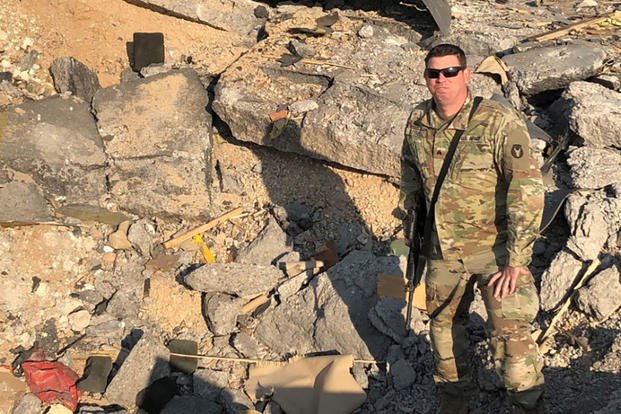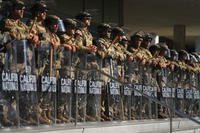Staff Sgt. Aaron Futrell did not anticipate a difficult deployment to Al Asad Air Base in Iraq in January 2020. The Islamic State terror group was on the run in the region, and his National Guard job in aviation operations made it very unlikely he'd ever be in harm's way.
Al Asad, which sits northwest of Baghdad, was not the type of smaller forward operating base typical of the earlier Iraq war where troops made due with spartan conditions and were regularly exposed to combat and danger. As a longtime hub of U.S. operations, the sprawling facility had a Green Beans coffee shop, a nice exchange store and gym, and many troops had personal amenities like video game systems.
"Normally, the base would need to be overrun for me to get shot at. I'm the definition of a 'fobbit,'" Futrell told Military.com, using a slang term to describe troops who usually don't leave base. "I sit in the [tactical operations center] all day on the radio and fill out reports."
Read Next: Veterans Swindled by Shuttered For-Profit Corinthian Colleges Get Loan Debt Erased
Then, Iran unexpectedly launched 15 ballistic missiles in an unprecedented attack on the base on Jan. 8, 2020. The strike narrowly avoided killing scores of U.S. troops, including Futrell and other Guard members, and brought tensions between Washington and Tehran to the boiling point.
Eventually, weeks later, it was revealed that at least 100 soldiers suffered traumatic brain injuries from the attack. For Futrell and others, the brain injuries would weigh on them daily and change their lives forever. But the long road to National Guard troops receiving the Purple Heart awards they were entitled to would take another two years, following military shortcomings in tracking injuries and resistance from senior leadership.
"Nobody has treated these injuries with the seriousness they deserve," said Futrell, who is now medically retired.
The Iran attack was downplayed from the start. The assault was retaliation for a U.S. drone strike that killed Maj. Gen. Qassem Soleimani, the commander of Iran's Quds Force military branch. Then-President Donald Trump initially reported in the weeks following the attack that no one was injured in the Iranian strike on Al Asad.
"I heard they had headaches and a couple of other things," Trump told reporters. "But I would say, and I can report, it is not very serious. Not very serious."
But Futrell, and at least eight other National Guardsmen from Ohio and New Hampshire, did suffer what turned out to be serious injuries.
Futrell was medically retired from the Ohio National Guard in May after a constant struggle with headaches, mental fatigue and other health issues as a result of the missile barrage. He was awarded a 90% disability rating from the Department of Veterans Affairs.
Confusion and Delays
About 80 troops have been awarded the Purple Heart for their combat injuries from the strike in early 2020. The Guardsmen from Ohio and most New Hampshire troops didn't receive the award until April -- more than two years after the attack. Michigan's National Guard gave out six Purple Hearts for the injuries in January and a single medal last year.
Traumatic brain injuries have been referred to as "the signature injury" of the post-9/11 wars, but it wasn't until 2011 that the Army codified Purple Heart awards for a concussive injury. Such awards have been relatively rare, given that these injuries are sometimes hard to diagnose or symptoms are sometimes not properly recorded.
Even with Iran's attack on Al Asad, it was unclear at the time whether those troops were eligible. A Defense Department Inspector General report released in November found that Army officials failed to determine whether all service members impacted by the explosions were diagnosed. Part of the problem, investigators found, was that commanders weren't aware of the regulations behind tracking injuries.
Purple Hearts aren't simply medals for soldiers to wear; they can open the door to numerous benefits and work as solid ammunition for veterans seeking care and disability compensation from the VA.
Futrell's award was approved by his company and brigade commanders, according to documents obtained by Military.com. However, it was rejected by Lt. Gen. Robert White more than three months after the attack.
White was the commander of forces on the ground in Iraq at the time, and is now the commander of Fort Hood, Texas. Maj. Tania Donovan, a spokesperson for the base, said White would not provide a statement on why he denied potentially dozens of Purple Hearts following the attack. Furthermore, it's still unclear what prompted the recent string of awards to National Guardsmen.
Unlike other military decorations, Army regulations are clear that Purple Hearts are an entitlement and that the award is "not recommended." Instead, the soldier is "entitled to it upon meeting specific criteria."
Multiple sources familiar with the awards process told Military.com that decorations can be kicked back for minor procedural violations, including spelling errors. However, none of those sources could identify any obvious errors with award paperwork obtained by Military.com.
Despite resistance from senior leadership and attempts by the Trump administration to downplay the strikes, Guardsmen eventually started getting recognition in January, starting with a ceremony for Michigan Guard troops with C Company, 3-238th Aviation Regiment, when Gov. Gretchen Whitmer presented their awards.
In April, Ohio awarded two Purple Hearts, one of which was for Futrell. New Hampshire also awarded five soldiers with the medal. All soldiers were a part of the same aviation regiment.
'You Feel Completely Helpless'
Just before the strike in 2020, about 2,000 U.S. troops were braced for some type of attack on the air base by Iran. Soldiers interviewed thought it would mostly be a volley of rocket-propelled grenades shot by Iranian-backed militias in the area, not the 1,000-pound warheads that rained down.
But still, commanders evacuated most personnel and aircraft from the base, leaving only a skeleton crew of firefighters, a small group of medical personnel and a light security element so the base would not be overrun in the event of a ground assault.
Chief Warrant Officer 3 Jonathan Shallow, a medical evacuation pilot, had just arrived on base. It was his first day there, and his flight crew had to pile into bunkers overnight.
Shallow had previous combat experience, but described the missile barrage as both terrifying and aggravating because he and other soldiers had no way to fight back. Instead, they sat and waited.
"The biggest difference in this incident is you feel completely helpless; you can't do anything except take cover and hope the next one doesn't hit you," Shallow, who serves with the New Hampshire National Guard, told Military.com. "Instead, with small-arms fire, you can shoot, move and communicate and have something to do."
For Capt. Brendan Meehan, the platoon leader, the best he could do was have his soldiers take cover, ideally in bunkers far from what might be targets for the missiles. The attack was launched around 1:30 a.m. and lasted for roughly three hours, with the massive missiles pounding the area around them.
"The missiles lit up the sky," Meehan said. "One T-wall was lifted up in the air and broke another bunker; one [missile] shattered the windows in a building 100 meters away."
T-walls are large concrete barriers typically used as a base's perimeter and to shield soldiers from blasts.
No service members at Al Asad lost limbs in the strike. All the injuries were related to head trauma -- something all of them still deal with in varying degrees.
Meehan lost part of his vision. He had to go through months of treatment for it to be corrected. But maintaining focus can still be mentally draining.
"We were lucky to get evaluated almost right away; pretty much everyone was diagnosed with concussion, TBI, some much worse than others," Meehan said. "I spent six months at Walter Reed. I'm considered to be fully recovered; my vision is back to what it used to be."
Living with the Wounds
The understanding of head trauma is still in its early stages after being taken more seriously following a combination of the post-9/11 wars and more attention on concussions in the NFL. Symptoms can range from headaches and migraines to memory issues, cognitive problems and mental health issues such as depression.
Jeffrey Howard, an associate professor at the University of Texas at San Antonio, told Military.com that there used to be a belief people generally got over head trauma, but modern research is increasingly pointing to those injuries spurring long-term and sometimes lifetime physical and mental health issues.
"The research is in between infancy and being a toddler. We have a rudimentary classification system that's just based on different symptoms," Howard said. "Just our understanding of how to classify injuries is rudimentary. We need a better physiological measurement of the injury that can be more precise."
In some cases, symptoms can be hard to separate from day-to-day forgetfulness or normal headaches. Some soldiers might forget where they put their keys, and identifying whether that's a normal experience or the result of deteriorated brain function can be frustrating.
"Some days, I wake up with a headache; it could just be because I had too much to drink last night," Shallow said. "There is no light that comes on that says this symptom is directly related. It's just you notice some things that are different from the past."
Futrell, who now runs a fishing lure business in Ohio, said he has to carefully plan out his days.
He described the sensation of having "a battery" now that provides his body with limited mental energy. If he has plans in the evening, he cannot do a lot during the day. He also sometimes forgets names and even his own address. Sometimes, the migraines can take him out for an entire day.
"I'm 90% disabled, but I don't look it. Most people look at me and I seem like a regular guy, I'm not missing any limbs. I try to keep the headaches to myself, so the public doesn't see it," Futrell said. "They don't see the effects of TBI. I understand why it's downplayed, but it shouldn't be."
-- Steve Beynon can be reached at Steve.Beynon@military.com. Follow him on Twitter @StevenBeynon.
Related: Traumatic Brain Injury Classifications Are Leading to Preventable Deaths, Report Says













